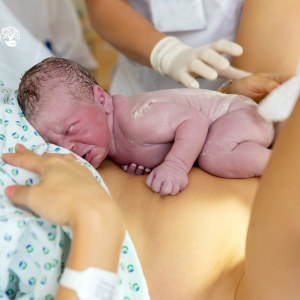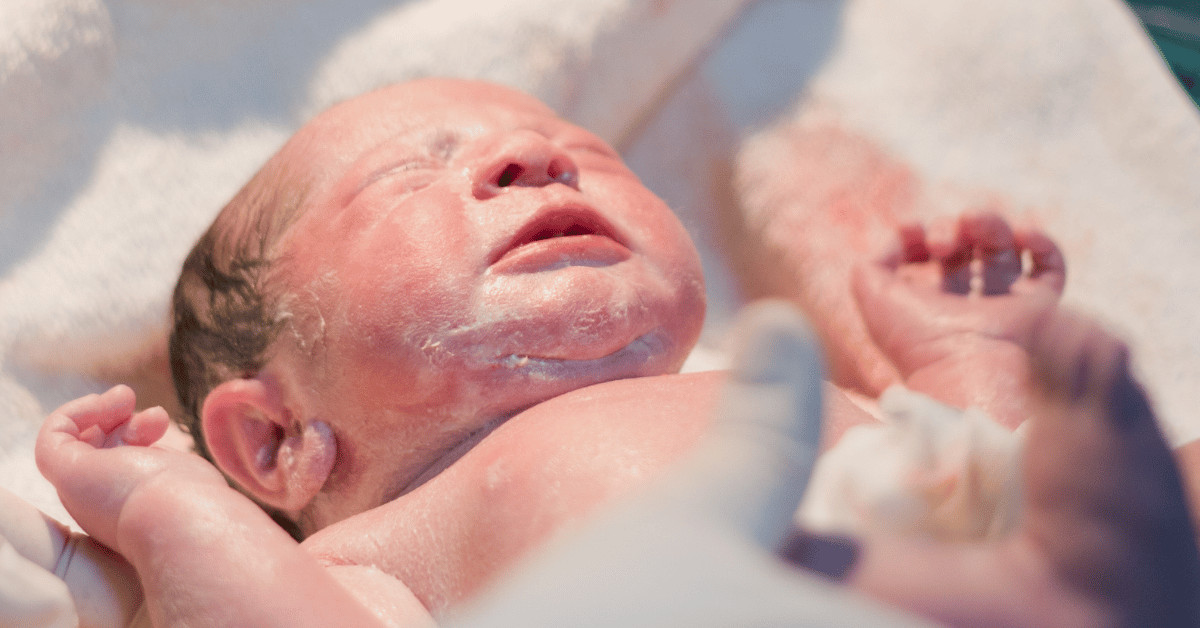Vernix caseosa, often referred to as vernix, is the creamy waxy coating found on the skin of a newborn at birth. Vernix is rich in water, lipids, proteins, and antimicrobial peptides – and, amazingly, it is thought to be unique to humans (1). And possibly sea lions! (2) While vernix used to be mistaken as something “gross” that needed to be wiped away immediately, in reality, it is an amazing substance that nurtures and protects your sweet baby.
In this article, you’ll learn about what vernix is, when it is developed, and what its benefits are. You’ll also get some information on managing vernix after birth.
What Is Vernix?
Vernix starts to form on a baby’s skin around the 20th week of gestation and it continues to accumulate until the baby is full term and production seems to stop or slow (1). Babies born past the 40 week mark may not have much vernix because they have already absorbed a lot of it.
 Vernix is actually a rather complex substance. It consists of 80% water and has a lipid component that includes substances like squalene, cholesterol, ceramides, wax esters, and sterol esters, which contribute to its effective waterproof and moisturizing properties (1). It also contains a protein component. The protein component of vernix is packed with potent antimicrobial polypeptides (1).
Vernix is actually a rather complex substance. It consists of 80% water and has a lipid component that includes substances like squalene, cholesterol, ceramides, wax esters, and sterol esters, which contribute to its effective waterproof and moisturizing properties (1). It also contains a protein component. The protein component of vernix is packed with potent antimicrobial polypeptides (1).
Of the 41 proteins that have been identified in vernix, 25 of them are unique to vernix! Research has shown that 39% of the identified vernix proteins are components of innate immunity and 29% have direct antimicrobial properties (1). Vernix also contains multiple additional proteins and amino acids, such as asparagine and glutamine, which are essential for skin cell development and repair (1).
Together, these components make vernix an incredibly effective natural barrier and moisturizer, uniquely adapted to protect and nourish a newborn’s skin.
The Role Of Vernix In Utero
In utero, vernix — with its lipid, protein, and amino acid content — contributes to the differentiation and maturation of fetal skin cells (3). Vernix also serves as a crucial hydration barrier. It prevents a fetus’s skin from becoming oversaturated with amniotic fluid, which can lead to softening and potential damage, while also acting as a microbial shield against potential intrauterine pathogens (1).
As the pregnancy approaches term, vernix also serves a practical purpose during labor and delivery: It acts as a natural lubricant, easing the baby’s passage through the birth canal. This lubrication minimizes physical stress on both the mother and the baby, making the delivery process slightly easier and potentially reducing the risk of injuries to the newborn’s skin.
The Role Of Vernix After Birth
After birth, the benefits of vernix extend into the early newborn phase. If left in place, vernix serves as a line of defense against external pathogens through its antimicrobial properties (1). If left to absorb naturally into the skin, vernix aids in lowering the skin pH, which is vital for developing the acid mantle — a key barrier against external irritants and infections (4).
Furthermore, vernix acts as nature’s perfect moisturizer and helps to keep the newborn’s skin supple and well-hydrated (1). Its insulating properties may also play a role in maintaining the baby’s body temperature (5), aiding in their adaptation from the aquatic environment of the womb to the air. Vernix also smells like mom, and its presence can be a way to ease the sensory transition from womb to world.
Benefits For Moms
Vernix isn’t just beneficial for newborns, it can also offer advantages for mothers. While there aren’t any specific studies on this, it can be assumed that the same properties that make vernix so valuable for protecting and nourishing a baby’s skin can also aid a mother during the postpartum period. During vaginal delivery, vernix that coats the baby can transfer to the mother’s vaginal and perineal areas, and the moisturizing and antimicrobial properties of vernix may contribute to the healing process of the perineal area after childbirth. The lipids and proteins in vernix help to soothe and repair the skin, potentially reducing the risk of infection and aiding in faster and more comfortable healing.
How Much Vernix Should My Baby Have?
The amount of vernix present at birth can vary based on several factors, including the mode of delivery and the gestational age of the baby (1). There is no such thing as “too much” vernix.
 Infants delivered via cesarean section usually retain more vernix, as they bypass the natural wiping process experienced during vaginal birth. The timing of delivery also influences vernix coverage; preterm babies often have less, potentially reducing their initial level of protection, while early term babies generally have more and post-term babies tend to have a little less, as they might have already absorbed much of their vernix.
Infants delivered via cesarean section usually retain more vernix, as they bypass the natural wiping process experienced during vaginal birth. The timing of delivery also influences vernix coverage; preterm babies often have less, potentially reducing their initial level of protection, while early term babies generally have more and post-term babies tend to have a little less, as they might have already absorbed much of their vernix.
The Link Between Vernix and Breast Milk
The immune proteins present in vernix share a remarkable similarity with those found in breast milk (6). Toward the end of pregnancy, the vernix begins to thin out, and some of it is released into the amniotic fluid, which the baby inhales and swallows. This results in a peptide-rich antimicrobial blend being introduced into the baby’s lungs and gastrointestinal system (7). This exposure is thought to help condition the baby’s digestive tract, acclimatizing it to the similar peptides that will later be delivered through breast milk.
The Standard Of Care For Vernix
According to the American Academy of Pediatrics “evidence-based national guidelines for newborn skincare do not exist,” and US maternity hospitals follow differing policies with regard to newborn skincare (8). While The World Health Organization recommends waiting at least 24 hours before bathing newborns (9), only 10% of US hospitals surveyed reported discharging infants without a bath (8). Even if bathtime is delayed, many hospitals will rub down your baby immediately after birth, removing much of the vernix.
As a parent, you can request that your baby keeps his or her vernix fully in place, so that you can massage it into your baby’s skin or leave it to absorb naturally. The majority absorbs within the first 24 hours, but it may take several days for vernix to fully absorb into the skin. If you choose, you can request that bath time be delayed or avoided altogether until you are home and ready to bathe your baby yourself. Another benefit of delaying bath time until you are home is that you can then use your own non-toxic and organic skincare products — or just water!
Summary
Vernix (Vernix caseosa) is a creamy waxy protective coating on newborns that develops during the second trimester and consists of lipids, proteins, and antimicrobial peptides. It protects the fetus’s skin from amniotic fluid while in utero and continues to benefit the newborn by maintaining skin moisture and providing defense against pathogens after birth. Vernix also aids in the mother’s perineal healing post-delivery. Despite its benefits, hospital practices on managing vernix vary widely. Parents may request to delay or skip bathtime to keep the vernix intact on their newborn so they can gently rub it in to maximize its protective effects.
References:
- Singh, G., & Archana, G. (2008). Unraveling the mystery of vernix caseosa. Indian journal of dermatology, 53(2), 54–60. https://doi.org/10.4103/0019-5154.41645
- Wang, D. H., Ran-Ressler, R., St Leger, J., Nilson, E., Palmer, L., Collins, R., & Brenna, J. T. (2018). Sea Lions Develop Human-like Vernix Caseosa Delivering Branched Fats and Squalene to the GI Tract. Scientific reports, 8(1), 7478. https://doi.org/10.1038/s41598-018-25871-1
- Agorastos, T., Lamberti, G., Vlassis, G., Zournatzi, B., & Papaloucas, A. (1986). Methods of prenatal determination of fetal maturity based on differentiation of the fetal skin during the last weeks of pregnancy. European journal of obstetrics, gynecology, and reproductive biology, 22(1-2), 29–40. https://doi.org/10.1016/0028-2243(86)90087-0
- Hoath, S. B., Pickens, W. L., & Visscher, M. O. (2006). The biology of vernix caseosa. International journal of cosmetic science, 28(5), 319–333. https://doi.org/10.1111/j.1467-2494.2006.00338.x
- Mardini, J., Rahme, C., Matar, O., Abou Khalil, S., Hallit, S., & Fadous Khalife, M. C. (2020). Newborn’s first bath: any preferred timing? A pilot study from Lebanon. BMC research notes, 13(1), 430. https://doi.org/10.1186/s13104-020-05282-0
- Doğan Merih, Y., Alioğulları, A., & Coşkuner Potur, D. (2021). The effect of vernix caseosa in preventing nipple problems among early postpartum women: A randomized-controlled single-blind clinical trial☆. Complementary Therapies in Clinical Practice, 45, 101475. https://doi.org/10.1016/j.ctcp.2021.101475
- Hoath, S., Pickens, W., Visscher, M., & Hoath, S. (2006). The biology of vernix caseosa. International Journal of Cosmetic Science, 28, 319–333. https://web.as.uky.edu/biology/faculty/cooper/BCTC/Vernix%20Caseosa-2.pdf
- Wisniewski, J. A., Phillipi, C. A., Goyal, N., Smith, A., Hoyt, A. E. W., King, E., West, D., Golden, W. C., & Kellams, A. (2021). Variation in Newborn Skincare Policies Across United States Maternity Hospitals. Hospital Pediatrics, 11(9), 1010–1019. https://doi.org/10.1542/hpeds.2021-005948
- World Health Organization. Caring for a newborn. (n.d.). Www.who.int. https://www.who.int/tools/your-life-your-health/life-phase/newborns-and-children-under-5-years/caring-for-newborns







